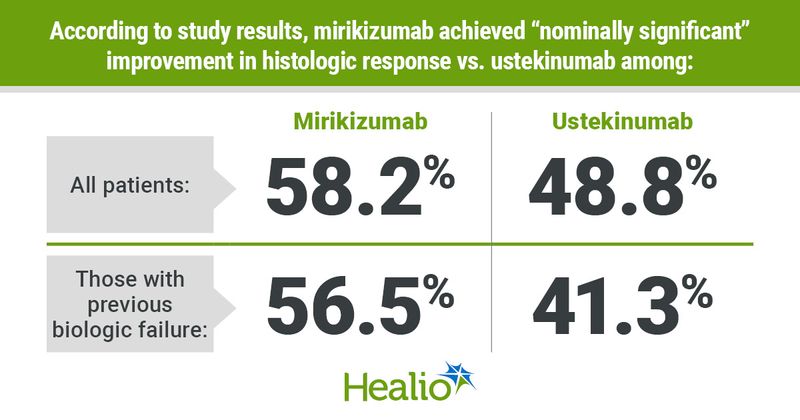Mirikizumab bests ustekinumab in histologic response at week 52 in Crohn’s
Key takeaways:
- “Nominally significant differences” were observed in histologic response at week 52 between mirikizumab and ustekinumab (58.2% vs. 48.8%).
- Similar differences were seen among those with prior biologic failure.
More patients with moderate to severe Crohn’s disease achieved histologic response at week 52 with mirikizumab vs. ustekinumab, regardless of prior biologic exposure, according to data presented at UEG Week.
“Treatment strategies for Crohn’s disease must evolve beyond traditional measures of clinical remission and endoscopy, to the evaluation of depth of intestinal healing by measuring histologic and transmural resolution,” Fernando Magro, MD, PhD, study author and head of clinical pharmacology at University Hospital São João, said in a related Lilly press release. “These histologic data build on the growing body of evidence for mirikizumab, which may provide a greater depth of mucosal healing for those living with this chronic, progressive disease.”

In the phase 3, randomized, double-blind, double-dummy, treat-through VIVID-1 trial, Magro and colleagues investigated the impact of mirikizumab (Omvoh, Lilly) vs. ustekinumab (Stelara, Janssen) on histologic response and remission, as well as combined endoscopic-histologic response and remission, at week 52 among patients with moderately to severely active CD. They also compared outcomes among those with vs. without a history of prior biologic failure.
According to study results, mirikizumab achieved “nominally significant” improvement in histologic response vs. ustekinumab among all patients (58.2% vs. 48.8%; difference = 9.6; 95% CI, 2.6-16.6) and those with previous biologic failure (56.5% vs. 41.3%; difference = 15.2; 95% CI, 4.7-25.7).
In addition, mirikizumab also outperformed ustekinumab in combined endoscopic-histologic response among all patients, although the difference was not statistically significant (41.4% vs. 34.4%; difference = 6.8; 95% CI, –0.3 to 14). However, these differences were nominally significant among those with prior biologic failure (39.6% vs. 27.8%; difference = 11.8; 95% CI, 2-21.7).
Researchers also observed nonsignificant numerical differences in histologic and combined endoscopic-histologic remission among all patients (30.2% vs. 28.9% and 17.2% vs. 14.8%, respectively) and those with previous biologic failure (24.3% vs. 19.8% and 13.3% vs. 8.7%).
“As the first company to report rigorous histologic and endo-histologic outcomes in Crohn’s disease that align with a recent [European Crohn’s and Colitis] position statement, Lilly is setting a higher bar for the evaluation of long-term treatment response in inflammatory bowel disease,” Mark Genovese, MD, senior vice president of Lilly immunology development, said in the release. “This includes more ambitious targets of mucosal healing, which we applied to compare mirikizumab’s histo-endoscopic effect to ustekinumab.”
He continued: “These data also broaden our understanding of the underlying inflammation that drives Crohn’s disease and may represent a critical step forward in helping health care providers and their patients make more informed choices about treatment.”
Reference:
- Lilly reports one-year histologic outcomes in phase 3 study of mirikizumab compared to ustekinumab for Crohn's disease. https://investor.lilly.com/news-releases/news-release-details/lilly-reports-one-year-histologic-outcomes-phase-3-study. Published Oct. 14, 2014. Accessed Oct. 16, 2024.

